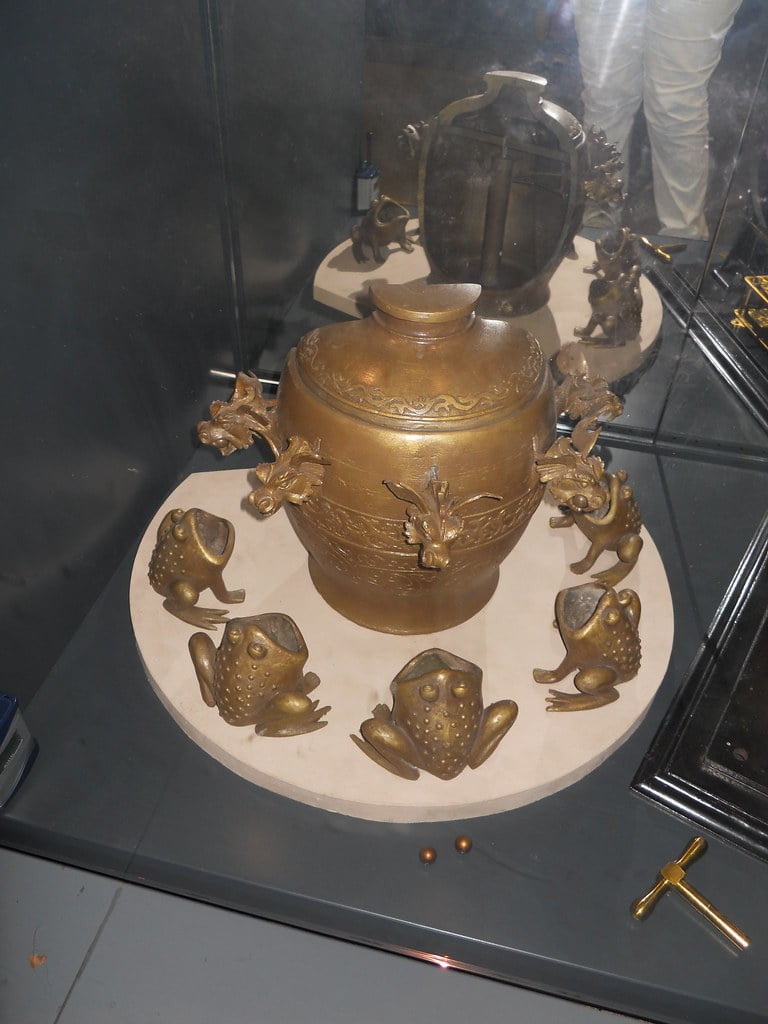Introduction: The Han Dynasty Seismograph
In 132 AD, during the rule of the Han Dynasty, Chinese polymath Zhang Heng created a remarkable device known as the Houfeng Didong Yi, also referred to as the Han Dynasty Seismograph. This device was the world’s first seismograph, designed to detect earthquakes and serve as an early warning system for distant tremors. Zhang Heng’s invention demonstrated the sophistication of ancient Chinese engineering and science in seismometer history, highlighting their understanding of natural phenomena and technological innovation. This blog explores the significance, function, and historical context of the Chinese seismograph, the gaps in the current research on this subject, and its lasting influence on earthquake detection technology. Discover The Han Dynasty Seismograph- Houfeng Didong Yi, Zhang Heng’s groundbreaking seismograph in China from 132 AD and its historical significance.

The Historical Context of the Han Dynasty and Seismographs
Before diving into the details of the Houfeng Didong Yi, it’s essential to understand the period in which it was developed. The Han Dynasty (202 BC – 220 AD) was one of China’s longest and most influential dynasties, known for its advancements in science, technology, and culture. Zhang Heng, a brilliant scientist, mathematician, and astronomer, was appointed as the Chief Astronomer of the Han court. He was tasked with studying celestial phenomena and natural disasters such as earthquakes, which were considered omens in ancient seismograph in China.

At that time, seismic activity had profound political and social implications. Earthquakes were seen as signs of the emperor losing the Mandate of Heaven, a divine right to rule. Consequently, early detection of earthquakes was critical to governance, prompting Zhang Heng to invent a device that could record tremors from afar and alert the emperor of impending disasters.
What Is a Seismograph and How Did Zhang Heng’s Device Work?
A seismograph is a sophisticated instrument that records the vibrations of the Earth caused by seismic waves from events such as earthquakes, volcanic eruptions, or tectonic movements. These devices are critical for monitoring seismic activity, providing valuable data for scientists and early warnings to the public in the event of impending disasters. While modern seismographs are electronic and highly precise, the foundation of seismometer history dates back nearly 2,000 years to Zhang Heng’s invention during the Han Dynasty.

Zhang Heng’s Houfeng Didong Yi: Design and Operation
Zhang Heng’s Houfeng Didong Yi (often translated as “instrument for measuring seasonal winds and the movements of the Earth”) was revolutionary in seismometer history. The device was constructed as a large bronze urn, standing around six feet in diameter. It featured a symmetrical design with eight intricately designed dragon heads arranged around the body of the urn. Each dragon faced a different cardinal direction—north, northeast, east, southeast, south, southwest, west, and northwest.
The dragons were not just decorative; they played a crucial role in the function of the device. Below each dragon head sat an open-mouthed toad. Inside the device, a pendulum-like mechanism or weighted metal ball was connected to a central pillar or rod. When an earthquake occurred, the pendulum would detect the subtle vibrations or shockwaves, causing one of the dragon heads to release a metal ball into the mouth of the toad below. The dragon head that dropped the ball corresponded to the direction from which the seismic waves originated, allowing the court officials to understand where the earthquake had occurred even if the tremors were not felt locally.
This basic mechanism, while simple compared to modern standards, was able to detect earthquakes from hundreds of miles away. Historical records suggest that the device successfully recorded an earthquake in Gansu, a province more than 400 miles from the capital, even though the tremors were not felt in the capital itself. This achievement demonstrated not only Zhang Heng’s ingenuity but also the profound understanding of physics and engineering that seismometer history existed in ancient China.
What Is a Sensor Used For in Seismographs?
A sensor in a seismograph is a device that detects vibrations in the Earth’s surface and converts them into an electrical signal or mechanical movement that can be recorded and analyzed. Modern seismographs use a range of sensors—primarily accelerometers and geophones—which are designed to pick up the tiniest ground movements. These sensors are critical for monitoring tectonic shifts and volcanic activity, offering early warnings to help minimize the loss of life and infrastructure damage.
The key function of a seismograph is to measure seismic waves, which are waves of energy that travel through the Earth’s crust after an earthquake. The sensor in a seismograph detects these waves and records the timing and intensity of the seismic event. This data helps scientists understand the magnitude and location of the earthquake.
Evolution of Seismic Sensors from Zhang Heng to Today
Zhang Heng’s Houfeng Didong Yi was the first known mechanical seismograph in China, designed to detect seismic waves, and while his design was purely mechanical, the same fundamental concept of monitoring ground motion is used in modern seismic sensors. However, today’s sensors are far more advanced:
- Analog Seismometers: After Zhang Heng’s invention, seismometers evolved over the centuries. Early analog devices, invented in the 19th century, used mechanical levers and springs to detect seismic movements. They produced graphical records, known as seismograms, which displayed the intensity and duration of an earthquake.
- Digital Sensors: Modern seismographs are highly advanced, employing electronic sensors and digital technology to capture even the slightest ground movements. These systems use piezoelectric materials, strain gauges, and graphene biosensors to measure ground shifts. Graphene biosensors, in particular, have the potential to provide ultra-sensitive readings, making seismic detection even more accurate than ever before.
- Practical Applications: Today, seismographs and their sensors are not only used for monitoring earthquakes but also for detecting volcanic activity, mapping underground resources, and even predicting tsunamis. They play an essential role in global disaster preparedness.
Modern Applications of Seismograph Technology
The seismograph has come a long way since Zhang Heng’s time, evolving into a highly sophisticated tool used for various applications. Today, seismic sensors are capable of detecting much smaller tremors and providing real-time data to authorities.
- Monitoring Tectonic Plates: One of the most significant advancements is the ability of modern seismographs to monitor the movement of tectonic plates. This is crucial for regions like the Pacific “Ring of Fire,” where tectonic activity is frequent. Seismographs detect subtle shifts in the Earth’s crust and provide valuable data to geologists, helping predict where and when earthquakes are likely to occur.
- Volcanic Activity: Seismographs are also used to monitor volcanic activity. By measuring the small tremors that precede eruptions, seismologists can predict eruptions and provide early warnings to affected regions. These instruments are essential in countries with active volcanoes, like Japan, Indonesia, and Iceland.
- Tsunami Prediction: Seismographs also play a crucial role in tsunami prediction. By detecting undersea earthquakes, seismologists can issue tsunami warnings to coastal communities, potentially saving thousands of lives.
- Exploration for Natural Resources: Seismic technology is widely used in oil and gas exploration. Seismographs help geologists map the Earth’s subsurface and locate reserves of natural gas and petroleum. This application demonstrates the versatility of seismic technology in both natural disaster prevention and resource extraction.

How Zhang Heng’s Seismograph Influenced Modern Seismology
Zhang Heng’s Houfeng Didong Yi laid the foundation for modern seismic monitoring. Although his device was based on mechanical principles rather than electronics, it established many of the key concepts used in modern seismology:
- Directional Sensitivity: Zhang Heng’s seismograph could detect the direction of an earthquake, a feature that is still critical in today’s seismographs. Knowing the source of an earthquake allows seismologists to understand tectonic plate interactions and assess the impact zone.
- Focus on Seismic Waves: Like Zhang Heng’s original invention, modern seismographs focus on recording seismic waves. Today, we categorize these waves into P-waves (primary, faster-moving waves) and S-waves (secondary, slower-moving waves). Advanced seismographs can detect the time difference between P-waves and S-waves, providing critical information about the location and intensity of the earthquake.
The Importance of Seismic Monitoring in Contemporary Society
Seismographs play an essential role in safeguarding lives and property by providing critical data for earthquake prediction, monitoring, and mitigation strategies. In modern society, they are indispensable tools in our efforts to understand and respond to seismic activities. Through technological advancements and better monitoring systems, seismologists can now deliver early warnings for earthquakes, tsunamis, and volcanic eruptions, giving governments and communities the time they need to prepare and respond.

Enhancing Early-Warning Systems
One of the key reasons seismographs are so vital today is their ability to integrate into early-warning systems. In earthquake-prone regions, countries like Japan and Chile have established networks of seismographs that monitor seismic activities in real time. These early-warning systems analyze seismic data and can detect the arrival of P-waves (primary seismic waves), which travel faster than the more destructive S-waves (secondary waves). Even a few seconds’ warning can give individuals, transportation systems, and emergency services enough time to take precautionary measures, such as halting trains or shutting down gas lines to prevent explosions.
For instance, during the 2011 Tōhoku earthquake in Japan, the early-warning system provided about 10 to 30 seconds of advance notice, which was enough time to slow down the Shinkansen bullet trains and prevent additional casualties.
The Role of Graphene Biosensors in Modern Seismographs
Seismographs have evolved significantly, with cutting-edge technologies enhancing their performance. One of the most promising innovations is the introduction of graphene biosensors. Graphene is an incredibly thin, strong, and sensitive material that can detect even the tiniest ground vibrations, making it an ideal component for future seismographs.
Graphene biosensors have the potential to vastly improve the accuracy and sensitivity of seismic detection systems. By incorporating these advanced sensors into seismographs, scientists can detect smaller tremors that were previously undetectable. This means that regions at risk for earthquakes will benefit from more precise measurements, leading to more accurate predictions and quicker responses.
These advances in sensor technology are particularly important in regions where microseismic activities—small earthquakes that precede larger, more devastating ones—are a concern. Detecting these smaller quakes early on can give authorities enough time to prepare for potentially larger seismic events.
Reducing Casualties and Economic Impact
Seismographs are crucial not only for predicting earthquakes but also for mitigating their impacts. In regions with a high population density, early warnings and monitoring systems have been shown to significantly reduce the number of casualties and economic damage. Advanced seismographs, equipped with modern sensors like graphene, allow for more effective disaster preparedness strategies. Governments can deploy better building codes, retrofit older buildings to withstand earthquakes, and prepare evacuation plans for high-risk areas.
The global economic impact of earthquakes is also staggering. According to the United Nations Office for Disaster Risk Reduction (UNDRR), earthquakes are among the most expensive natural disasters, causing trillions of dollars in damage worldwide. Accurate and sensitive seismographs can help mitigate these costs by enabling better planning and resource allocation before and after an event.
Seismic Monitoring Beyond Earthquakes
Modern seismographs also have applications beyond earthquake detection. They play a key role in volcanic monitoring, providing data that helps predict eruptions by recording the seismic activity underneath volcanoes. In countries like Iceland and Indonesia, where volcanic activity is common, seismographs are essential for issuing evacuation orders and mitigating volcanic hazards.
Seismic monitoring is also used for tsunami prediction. Tsunamis are typically triggered by undersea earthquakes, and modern seismic networks can detect these tremors quickly, giving coastal communities enough time to evacuate.
Global Seismic Networks and Cooperation
Seismic monitoring has become a global effort, with many countries sharing data through international seismic networks. Organizations such as the Global Seismographic Network (GSN) collect seismic data from around the world to monitor earthquakes, assess global tectonic activity, and improve our understanding of how the Earth’s plates move.
The integration of graphene biosensors, machine learning algorithms, and AI-powered monitoring systems into global seismic networks promises to take seismic detection to new levels of precision. Machine learning can analyze patterns in seismic data and help predict earthquakes more accurately, while AI systems can process massive amounts of data in real time, improving the speed and reliability of seismic warnings.
The Future of Seismograph Technology
Looking ahead, seismographs are expected to become even more accurate and sensitive, particularly with ongoing research into nanotechnology and material science. These advances are poised to revolutionize seismic monitoring, enabling scientists to detect micro-vibrations that could serve as early indicators of larger seismic events.
In addition, the continued integration of AI into seismology will allow for quicker and more reliable interpretations of seismic data, potentially saving more lives and reducing the devastation caused by earthquakes. These technologies will not only enhance early-warning systems but will also aid in disaster recovery by providing precise data about the strength and location of seismic events.
FAQ
What is the Han Dynasty seismograph?
The Han Dynasty seismograph, invented in 132 CE by Zhang Heng, was the world’s first known earthquake-detecting instrument. It looked like a large bronze vessel with eight dragon heads on the outside, each holding a ball. When an earthquake occurred, a mechanism inside would release a ball into a toad’s mouth below, showing the direction of the quake.
How did the Han Dynasty seismograph work?
The seismograph used a pendulum-like mechanism inside the bronze vessel. When the ground shook, the pendulum shifted and triggered a release mechanism. A ball then dropped from one of the dragon heads into a toad’s mouth, pointing to the direction of the earthquake’s epicenter—even if tremors were not felt locally.
Why was the Han Dynasty seismograph important?
This invention was revolutionary because it: Allowed early detection of earthquakes, even from far distances. Helped the imperial court prepare disaster relief faster. Represented a major scientific achievement in understanding natural phenomena. It showed the Han Dynasty’s strength in both engineering and disaster management.
Who invented the seismograph in ancient China?
The seismograph was invented by Zhang Heng (78–139 CE), a Chinese polymath skilled in astronomy, mathematics, and engineering. His work demonstrated advanced knowledge of mechanics and natural science more than 1,800 years before modern seismology.
How accurate was the Han Dynasty seismograph?
Historical records suggest that the instrument could detect earthquakes hundreds of kilometers away. For example, it once indicated an earthquake to the west that was not felt in the capital Luoyang, but messengers later confirmed the event. While not as precise as modern seismographs, it was remarkably effective for its time.
What does the design of the seismograph symbolize?
The seismograph was as artistic as it was scientific: Dragons represented power and cosmic balance. Toads symbolized earth and receptiveness. The circular vessel mirrored the harmony of heaven and earth. This design blended Chinese cosmology with practical engineering.
How does the Han Dynasty seismograph compare to modern technology?
The ancient seismograph indicated only the direction of an earthquake. Modern seismographs measure magnitude, distance, and intensity with extreme precision. Today’s digital systems provide real-time data and global monitoring. Still, Zhang Heng’s invention laid the foundation for earthquake science, proving humanity’s early desire to predict and understand natural disasters.
Conclusion
The Houfeng Didong Yi, an ancient Chinese seismograph invented during the Han Dynasty, stands as one of the earliest known tools for detecting earthquakes. Created by the polymath Zhang Heng in 132 AD, this remarkable instrument is a testament to China’s innovative spirit in understanding natural phenomena. Its design was based on a sophisticated system of levers and balls that could indicate the direction of seismic activity. The invention of this Han Dynasty seismograph marks a significant milestone in the history of seismometers, as it allowed ancient China to detect earthquakes far from their epicenters.
Seismographs are essential in modern society, serving as a lifeline for communities vulnerable to seismic events. From predicting earthquakes and volcanic eruptions to issuing tsunami warnings, seismographs provide data that help save lives and minimize economic damage. The development of advanced sensors like graphene biosensors promises to enhance the functionality of seismographs, making them even more sensitive and reliable. As global seismic networks continue to expand and integrate new technologies, the future of seismic monitoring looks brighter than ever.
By understanding the evolution of the seismograph in China, we can appreciate how the ancient Chinese seismograph paved the way for modern earthquake detection technologies. This achievement underscores the advanced scientific thinking of the Han Dynasty, and Zhang Heng’s seismograph remains a cornerstone in the global development of seismology. The legacy of the seismograph in the Han Dynasty continues to inspire modern efforts in earthquake prediction and monitoring.
If you’re interested in learning more about ancient and modern technologies that have shaped our world, be sure to check out my other blogs on the Evolution of the Progress platform.






